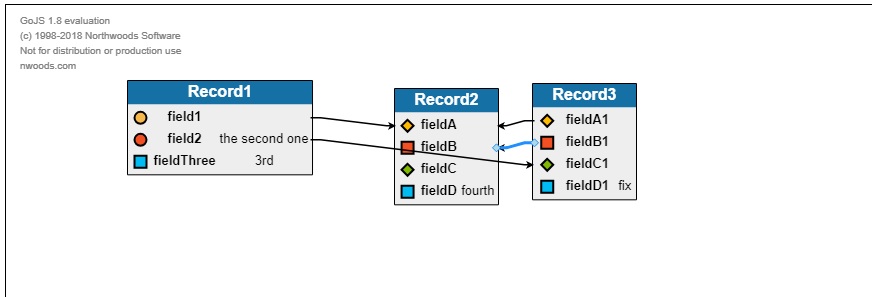Hi ,
I am using the gojs for column mapping features. Once the diagram is loaded I have three groups named Record1, Record2 and Record3 refer image
what needed:
1.Should not allow link(connection) from record2 to record1 and record3 to record1 and also record2 to record3
2.only way linking should happen is from record1 to others.
3.Should not delete the fields and the group by delete button
Code Below:
function init() {
if (window.goSamples) goSamples(); // init for these samples – you don’t need to call this
var $ = go.GraphObject.make; // for conciseness in defining templates
myDiagram =
$(go.Diagram, "myDiagramDiv",
{
initialContentAlignment: go.Spot.Center,
validCycle: go.Diagram.CycleNotDirected, // don't allow loops
// For this sample, automatically show the state of the diagram's model on the page
"ModelChanged": function(e) {
if (e.isTransactionFinished) showModel();
},
"undoManager.isEnabled": true
});
// This template is a Panel that is used to represent each item in a Panel.itemArray.
// The Panel is data bound to the item object.
var fieldTemplate =
$(go.Panel, "TableRow", // this Panel is a row in the containing Table
new go.Binding("portId", "name"), // this Panel is a "port"
{
background: "transparent", // so this port's background can be picked by the mouse
fromSpot: go.Spot.LeftRightSides, // links only go from the right side to the left side
toSpot: go.Spot.LeftRightSides,
// allow drawing links from or to this port:
fromLinkable: true, toLinkable: true
},
{ // allow the user to select items -- the background color indicates whether "selected"
//?? maybe this should be more sophisticated than simple toggling of selection
click: function(e, item) {
// assume "transparent" means not "selected", for items
var oldskips = item.diagram.skipsUndoManager;
item.diagram.skipsUndoManager = true;
if (item.background === "transparent") {
item.background = "dodgerblue";
} else {
item.background = "transparent";
}
item.diagram.skipsUndoManager = oldskips;
}
},
$(go.Shape,
{ width: 12, height: 12, column: 0, strokeWidth: 2, margin: 4,
// but disallow drawing links from or to this shape:
fromLinkable: false, toLinkable: false },
new go.Binding("figure", "figure"),
new go.Binding("fill", "color")),
$(go.TextBlock,
{ margin: new go.Margin(0, 2), column: 1, font: "bold 13px sans-serif",
// and disallow drawing links from or to this text:
fromLinkable: false, toLinkable: false },
new go.Binding("text", "name")),
$(go.TextBlock,
{ margin: new go.Margin(0, 2), column: 2, font: "13px sans-serif" ,
fromLinkable: false, toLinkable: false },
new go.Binding("text", "info"))
);
// This template represents a whole "record".
myDiagram.nodeTemplate =
$(go.Node, "Auto",
new go.Binding("location", "loc", go.Point.parse).makeTwoWay(go.Point.stringify),
// this rectangular shape surrounds the content of the node
$(go.Shape,
{ fill: "#EEEEEE" }),
// the content consists of a header and a list of items
$(go.Panel, "Vertical",
// this is the header for the whole node
$(go.Panel, "Auto",
{ stretch: go.GraphObject.Horizontal }, // as wide as the whole node
$(go.Shape,
{ fill: "#1570A6", stroke: null }),
$(go.TextBlock,
{
alignment: go.Spot.Center,
margin: 3,
stroke: "white",
textAlign: "center",
font: "bold 12pt sans-serif"
},
new go.Binding("text", "key"))),
// this Panel holds a Panel for each item object in the itemArray;
// each item Panel is defined by the itemTemplate to be a TableRow in this Table
$(go.Panel, "Table",
{
name: "TABLE",
padding: 2,
minSize: new go.Size(100, 10),
defaultStretch: go.GraphObject.Horizontal,
itemTemplate: fieldTemplate
},
new go.Binding("itemArray", "fields")
) // end Table Panel of items
) // end Vertical Panel
); // end Node
myDiagram.linkTemplate =
$(go.Link,
{ relinkableFrom: true, relinkableTo: true, toShortLength: 4 }, // let user reconnect links
$(go.Shape, { strokeWidth: 1.5 }),
$(go.Shape, { toArrow: "Standard", stroke: null })
);
var DS = [
{
key: "Record1",
fields: [
{ name: "field1", info: "", color: "#F7B84B", figure: "Ellipse" },
{ name: "field2", info: "the second one", color: "#F25022", figure: "Ellipse" },
{ name: "fieldThree", info: "3rd", color: "#00BCF2" }
],
loc: "0 0",
fromlink: true
},
{
key: "Record2",
fields: [
{ name: "fieldA", info: "", color: "#FFB900", figure: "Diamond" },
{ name: "fieldB", info: "", color: "#F25022", figure: "Rectangle" },
{ name: "fieldC", info: "", color: "#7FBA00", figure: "Diamond" },
{ name: "fieldD", info: "fourth", color: "#00BCF2", figure: "Rectangle" }
],
loc: "250 0",
tolink: true
},
{
key: "Record3",
fields: [
{ name: "fieldA1", info: "", color: "#FFB900", figure: "Diamond" },
{ name: "fieldB1", info: "", color: "#F25022", figure: "Rectangle" },
{ name: "fieldC1", info: "", color: "#7FBA00", figure: "Diamond" },
{ name: "fieldD1", info: "fix", color: "#00BCF2", figure: "Rectangle" }
],
loc: "500 0",
tolink: true
}
]
console.log(DS);
myDiagram.model =
$(go.GraphLinksModel,
{
linkFromPortIdProperty: "fromPort",
linkToPortIdProperty: "toPort",
nodeDataArray: DS,
linkDataArray: [
{ from: "Record1", fromPort: "field1", to: "Record2", toPort: "fieldA" },
{ from: "Record1", fromPort: "field2", to: "Record3", toPort: "fieldC1" },
{ from: "Record1", fromPort: "fieldThree", to: "Record2", toPort: "fieldB" }
]
});
// this is a bit inefficient, but should be OK for normal-sized graphs with reasonable numbers of items per node
function findAllSelectedItems() {
var items = [];
for (var nit = myDiagram.nodes; nit.next(); ) {
var node = nit.value;
var table = node.findObject("TABLE");
if (table) {
for (var iit = table.elements; iit.next(); ) {
var itempanel = iit.value;
if (itempanel.background !== "transparent") items.push(itempanel);
}
}
}
return items;
}
// Override the standard CommandHandler deleteSelection behavior.
// If there are any selected items, delete them instead of deleting any selected nodes or links.
myDiagram.commandHandler.canDeleteSelection = function() {
// true if there are any selected deletable nodes or links,
// or if there are any selected items within nodes
return go.CommandHandler.prototype.canDeleteSelection.call(myDiagram.commandHandler) ||
findAllSelectedItems().length > 0;
};
myDiagram.commandHandler.deleteSelection = function() {
var items = findAllSelectedItems();
if (items.length > 0) { // if there are any selected items, delete them
myDiagram.startTransaction("delete items");
for (var i = 0; i < items.length; i++) {
var panel = items[i];
var nodedata = panel.part.data;
var itemarray = nodedata.fields;
var itemdata = panel.data;
var itemindex = itemarray.indexOf(itemdata);
myDiagram.model.removeArrayItem(itemarray, itemindex);
}
myDiagram.commitTransaction("delete items");
} else { // otherwise just delete nodes and/or links, as usual
go.CommandHandler.prototype.deleteSelection.call(myDiagram.commandHandler);
}
};
showModel(); // show the diagram's initial model
function showModel() {
document.getElementById("mySavedModel").textContent = myDiagram.model.toJson();
// console.log(myDiagram.model);
}
}
I tried few options based on the dicuments… but not able to acheive it .probably missing something.
Let me know its possible
Thanks
Dev
